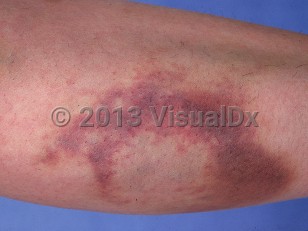Autoerythrocyte sensitization in Adult
Alerts and Notices
Important News & Links
Synopsis

Autoerythrocyte sensitization, also known as Gardner-Diamond syndrome or psychogenic purpura, was initially described by Gardner and Diamond in 1955 as an abnormal response to bruising. The designation "autoerythrocyte sensitization" is from this and other early reports that patients seemed to react to an intradermal injection of their own erythrocytes. However, later reports were not able to confirm this finding consistently.
The disorder is characterized by bruising without clear precipitating causes or definite trauma. Women are most frequently affected. The painful bruises vary in size and may have peculiar or geometric shapes. Bruising is most commonly seen on the lower extremities, but other sites of involvement have been reported. Associated symptoms include abdominal pain, nausea, vomiting, diarrhea, and headache. Prodromal symptoms such as pain, warmth, or itching at the site prior to the bruising have been described. The bruises resolve in approximately 2 weeks but recur.
The etiology of autoerythrocyte sensitization is unknown. Reported associations include the presence of a psychiatric disorder (including depression, borderline personality disorder, obsessive-compulsive disorder, and anxiety), a preceding traumatic event (such as a procedure or surgery up to 2 years prior to the onset of symptoms), or severe psychosocial stress (such as marital conflicts, or death or illness of a family member).
The disorder is characterized by bruising without clear precipitating causes or definite trauma. Women are most frequently affected. The painful bruises vary in size and may have peculiar or geometric shapes. Bruising is most commonly seen on the lower extremities, but other sites of involvement have been reported. Associated symptoms include abdominal pain, nausea, vomiting, diarrhea, and headache. Prodromal symptoms such as pain, warmth, or itching at the site prior to the bruising have been described. The bruises resolve in approximately 2 weeks but recur.
The etiology of autoerythrocyte sensitization is unknown. Reported associations include the presence of a psychiatric disorder (including depression, borderline personality disorder, obsessive-compulsive disorder, and anxiety), a preceding traumatic event (such as a procedure or surgery up to 2 years prior to the onset of symptoms), or severe psychosocial stress (such as marital conflicts, or death or illness of a family member).
Codes
ICD10CM:
D69.2 – Other nonthrombocytopenic purpura
SNOMEDCT:
275446004 – Gardner-Diamond syndrome
D69.2 – Other nonthrombocytopenic purpura
SNOMEDCT:
275446004 – Gardner-Diamond syndrome
Look For
Subscription Required
Diagnostic Pearls
Subscription Required
Differential Diagnosis & Pitfalls

To perform a comparison, select diagnoses from the classic differential
Subscription Required
Best Tests
Subscription Required
Management Pearls
Subscription Required
Therapy
Subscription Required
References
Subscription Required
Last Reviewed:12/12/2019
Last Updated:01/26/2020
Last Updated:01/26/2020
Autoerythrocyte sensitization in Adult

